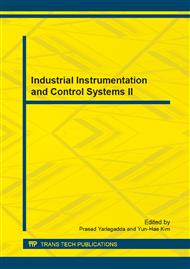[1]
Wang Shao-hui, Wang Gao-li. Analysis of Passive Attack on RFID Authentication Protocol ULAP [J]. Computer Engineering, Beijing, 36(2010) 17-19.
Google Scholar
[2]
Wang Yiwei, Zhao Yuehua, LI Xiaocong. RFID Authentication Scheme Based on EPC-C1G2 Standard [J]. Computer Engineering, Beijing, 36 (2010) 153-154, 157.
Google Scholar
[3]
Ding Zhenhua, Li Jintao, Feng Bo. Research on Hash- Based RFID Security Authentication Protocol[J]. Journal of Computer Research and Development, Beijing, 46(2009) 583-592.
Google Scholar
[4]
Denoia, Lynn A., Olsen, Anne L. RFID and Application Security. Journal of Research and Practice in Information Technology, Beijing, 41(2009) 209-221.
Google Scholar
[5]
Duncan McFarlane, Sanjay Sarma, Jin Lung Chirn, C. Y Wong, Kevin Ashton. Auto ID Systems and Intelligent Manufacturing Control. Engineering Applications of Artificial Intelligence, Beijing, 16(2003) 365-376.
DOI: 10.1016/s0952-1976(03)00077-0
Google Scholar
[6]
Deng Miaolei, Wang Yulei, Qui Gang. Authentication Protocol for RFID without Back-end Database [J]. Journal of Beijing University of Posts and Telecommunications, Beijing, 32(2009) 59-62, 67.
Google Scholar
[7]
Alex X. Liu, LeRoy A. Bailey. PAP: A Privacy and Authentication Protocol for Passive RFID Tags[J]. Computer Communications, 32(2009) 1194-1199.
DOI: 10.1016/j.comcom.2009.03.006
Google Scholar
[8]
Deng Miao-lei, MA Jian-feng, Zhou Li-hua. Design of Anonymous Authentication Protocol for RFID[J]. Journal on Communications, Beijing, 30(2009) 20-26.
Google Scholar
[9]
Deng Miao-lei, Huang Zhao-he, Lu Zhibo. 'Secure RFID Authentication Protocol for EPCGen2[J]. Computer Science, Chongqing, 37(2010) 115-117.
Google Scholar
[10]
Xie Chuan. RFID Authentication Protocol based on Hash Function and Key Array[J]. Journal of Computer Applications, Beijing, 31(2011) 805 -807, 811.
DOI: 10.3724/sp.j.1087.2011.00805
Google Scholar
[11]
Qian Ping, Wu Meng. A Security RFID Authentication Method Based on Hash Function. Telecommunications Science, Beijing, 10(2011), 109-112.
Google Scholar
[12]
Yang Hua, Wang Dong. Hash Function Construction Algorithm Applying to UHF RFID Authentication[J]. Journal of Computer Applications, Cheng du, 31, (2011) 805-807, 811.
Google Scholar
[13]
Zhu Yong-Bin, Feng Deng-Guo. Design and Analysis of Cryptographic Protocols for RFID[J]. Chinese Journal of Computers, Beijing, 29(2006) 581-589.
Google Scholar
[14]
Deng Miaolei, Huang Zhaohe, Yang Lushan. Data Synchronization of Authentication Protocols[J]. Computers Science, Chongqing, 37(2010) 83-85.
Google Scholar
[15]
Tang Jing, Ji Dong-yao. Design and Analysis of Security Protocols for RFID Based on LPN Problem[J]. Journal of Electronics & Information Techoonolgy, Beijing, 31(2009) 439-443.
Google Scholar
[16]
Liu Qin-hua, Huo Teng-fei, DengYi-qun. A Random Authentication Scheme Based on Hash Function[J]. Communications Techonology. Beijing, 42 (2009) 59-61.
Google Scholar
[17]
Li Jing, XiaYou-ming, Jiang Yi-ting. RFID Authentica- tion Protocol in Conformity with the Gen-2 Standard [J]. Journal of Yunnan University Nationalities, Kunming, 19 (2010) 241-243, 252.
Google Scholar
[18]
Yang Jie, Cao Hao, Li Pin. General RFID authentication and authorization protocol model. Journal of Yunnan University Nationalities (Natural Sciences Edition), Kunming, 27 (2007) 107-109, 115.
Google Scholar
[19]
Wang Tao. General RFID authentication and authorization protocol model[J]. Computer Engineering and Applictions, Beijing, 44(2008) 57-60.
Google Scholar
[20]
Robin Doss, Wanlei Zhou, Saravanan Sundaresan, Shui Yu, Longxiang Gao. A minimum disclosure approach to authentication and privacy in RFID systems[J]. Computer Networks, 56 (2012)3401-3416.
DOI: 10.1016/j.comnet.2012.06.018
Google Scholar
[21]
Jung-Sik Cho, Sang-Soo Yeo, Sung Kwon Kim. Securing against brute-force attack: A hash-based RFID mutual authentication protocol using a secret value[J], Computer Communications, 34 (2011)391 -397.
DOI: 10.1016/j.comcom.2010.02.029
Google Scholar
[22]
Tong-Lee Lim, Saravanan Sundaresan, Wanlei Zhou. A practical quadratic residues based scheme for authentication and privacy in mobile RFID systems. Ad Hoc Networks, 11 (2013) 383–396.
DOI: 10.1016/j.adhoc.2012.06.015
Google Scholar


